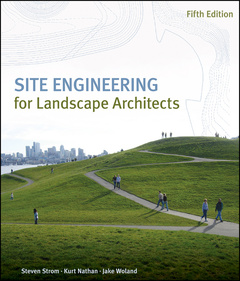Description
Site engineering for landscape architects: web site
Authors: STROM Steven, NATHAN Kurt, WOLAND Jake
Language: English
Approximative price 90.46 €
Subject to availability at the publisher.
Add to cart368 p. · Hardback
Description
/li>Contents
/li>
Site Engineering for Landscape Architects
Fifth Edition
The leading guide to site design and engineering, now fully updated.
The leading choice for site engineering, planning, and construction courses, as well as for practitioners in the field, Site Engineering for Landscape Architects, Fifth Edition introduces the principles and techniques of basic site engineering for grading, drainage, earthwork, and road alignment. The Fifth Edition maintains the text"s recognized quality, while revising its content to keep readers up to date with current technologies in the field of landscape architecture.
Introducing landform and the language of its design, the text explores the site engineering concepts essential to practicing landscape architecture today*from interpreting landform and contour lines, to designing horizontal and vertical road alignments, to construction sequencing, to designing and sizing stormwater management systems. Integrating design with the construction and implementation processes, the authors provide students with a progressive understanding of the subject matter.
This new edition expands its coverage of such current topics as sustainability, green roofs, bioengineering, and lightweight and structural soils. It also features new case studies, as well as inspiring graphics and color photos with real-world examples.
Perfect for use as a study guide for the most difficult section of the Landscape Architecture Registration Exam (LARE) or as a handy professional reference, Site Engineering for Landscape Architects, Fifth Edition gives readers a strong foundation for engaging in site development that is environmentally sensitive and intellectually stimulating.
Why is an understanding of this material important?
The Design Language of Site Engineering.
2. Grading Constraints.
Environmental Constraints.
Functional Constraints.
Summary of Critical Constraints.
3. Contours and Form.
Definition.
Constructing a Section.
Characteristics of Contour Lines.
Contour Signatures and Landform.
Case Studies.
4. Interpolation and Slope.
Topographic Data.
Interpolation.
Calculating Slope.
Slopes Expressed As Ratios and Degrees.
Slope Analysis.
5. Grading of Simple Design Elements.
Grading of Linear Elements.
Grading By Proportion.
Visualizing Topography from Contour Lines.
Grading of Planar Areas.
Swales to Divert Runoff.
Area Grading Process.
6. Grading Process.
Introduction.
Applying the Grading Process.
Grading Plan Graphics.
7. Soils in Construction
Role of Soil in Site Planning.
Implications of Soils to Site Construction.
Geotechnical Exploration and Soil Investigation.
Soil Characteristics.
Soil Classification.
Engineering Properties of Soils.
Structural Soils.
Light Weight Soils.
Geotextiles.
Construction Sequence for Grading.
Placing and Compacting Soils.
Earthwork Specifications.
8. Earthwork.
Definitions.
Grading Operations.
Computation of Cut and Fill Volumes.
9. Storm Water Management.
Storm Runoff.
Hydrologic Cycle.
Nature of the Problem.
Management Philosophy.
Storm Water Management Strategies.
Principles and Techniques.
Case Studies.
Summary.
10. Soil Erosion and Sediment Control.
Introduction.
Regulatory Requirements.
Soil Erosion Factors.
Erosion and Sedimentation Processes.
Erosion and Sediment Control Principles.
Development of an Erosion and Sediment Control Plan.
Runoff Considerations.
Construction Sequencing.
Erosion Control Measures.
Sediment Control Measures.
Case Studies.
Summary.
11. Determining Rates and Volumes of Storm Runoff: The Rational and Modified Rational Methods.
Introduction.
Rational Method.
Modified Rational Method.
Volumes of Runoff, Storage and Release.
Required Storage for Detention or Retention Ponds by the Modified Rational Method.
Summary.
12. Natural Resources Conservation Service Methods of Estimating Runoff Rates, Volumes, and Required Detention Storage.
Introduction.
Rainfall.
Procedures of TR55.
Volume for Detention Storage.
Summary.
13. Designing and Sizing Storm Water Management Systems.
Management Systems.
Design and Layout of Drainage Systems.
Applications.
Subsurface Drainage.
Summary.
14. Site Layout and Dimensioning.
Hierarchy of Dimensioning.
Dimensioning Guidelines.
Horizontal Layout Methods.
Layout Plans.
15. Horizontal Road Alignment.
Types of Horizontal Curves.
Circular Curve Elements.
Circular Curve Formulas.
Degree of Curve.
Stationing.
Horizontal Sight Distance.
Construction Drawing Graphics.
Horizontal Alignment Procedures.
Superelevation.
Case Study.
16. Vertical Road Alignment.
Vertical Curve Formula.
Equal Tangent Curves.
Calculating the Locations of High and Low Points.
Unequal Tangent Curves.
Construction Drawing...




